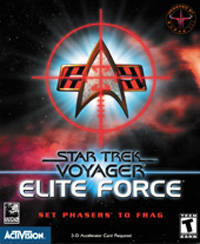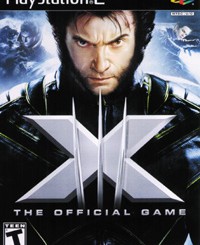 Star Trek Voyager: Elite Force
Star Trek Voyager: Elite Force
(Activision for the PC)
by Eric Johnson
I understand that this is the third Star Trek PC game review in as many issues, so let me assure you that if it were not the best of the three, Voyager: Elite Force would’ve passed into oblivion without mention. Cut from the same cloth as Quake III, it’s an A-list first-person shooter that allows you to explore and kill in an outstandingly good and faithfully-reproduced two-part episode of the Voyager television series. This tidy little masterpiece combines a short but engrossing single-player game with an oversimplified but surprisingly intense multi-player experience. When I first heard about Elite Force, my expectations weren’t high. After all, the high-concept Voyager is the weakest series to bear the Star Trek name, and what form a first-person translation of that material might take on was anybody’s guess.
As it turns out, they did a thoroughly kick-ass job of translating one of the most recognizable game genres into a completely convincing interactive episode. The primary obstacle to getting it right was coming up with an imaginative way to inject all these intense action sequences into the Star Trek formula, which has generally avoided blazing gun battles. The solution is to make the protagonist second-in-command of a hazard team specially-trained to deal with high-risk situations and hostile environments. Isolated from the rest of the Federation by a seventy-year journey through unexplored territory with a crew of fewer than two hundred people, every casualty represents an irreplaceable loss of vital manpower. Since no one on Voyager ever gets laid and they don’t bother taking on more than one bombshell cyborg at a time, preparing an elite squad for hazardous duty is the best way to keep casualties under control. This team takes on its first major challenge when Voyager becomes trapped in “the Forge,” a vast junkyard of derelict alien vessels awaiting digestion by a race of conquering crabs and bipedal roaches.
The genius of this setting is that it gives an excuse to explore a variety of ships and interact with a cross-section of different species. All of these environments are wonderfully-rendered, and the ship interiors are most impressive. The Borg vessels, for example, are ornate bio-mechanical constructions with walls comprised of green lights and black metal meshed together in a cold hive-like labyrinth. The levels are short but very well-designed, never quite feeling tacked on or excessively closed in. Although you’re always in an interior space, you’re not constantly stuck in claustrophobic hallway and some areas are truly vast.
The sound is spectacular. Over the past thirty years, the Star Trek people have built up an unequaled library of sound effects, and here it gets to take advantage of the very best of them. The sounds that accompany beaming from place to place and the agonized scream of a disintegrating man are my personal favorites.
The single player game is indeed very short – it should take about ten to fifteen hours to complete – but it makes up for its brevity by being well-designed down to the smallest detail. It avoids getting bogged down in first-person shooter clichés like torch-lit dungeons and exploding boxes. All the basic elements one would expect from this type of action game are present. Like Quake III, the majority of gameplay is spent juggling weapons to fend off hordes of alien trash in a series of explosive firefights. Unlike Quake, there’s a huge amount of interaction with non-player characters, and the tasks you perform are immensely varied. In addition, Elite Force is unusual because it forces you to play in the presence of others, working with them and occasionally depending on them as they are remarkably intelligent. The same cannot be said of the enemies. They’re unfortunately very stupid and overly aggressive. It’s a common criticism to say “I wish the computer-controlled opponents were smarter.” Indeed, this is a serious problem and limits the amount of fun to be had from what is otherwise a superbly rendered game.
The illusion of being inside a virtual episode is completed by your interaction with other characters. Conversations are occasionally sappy, but always well done. Lt. Alex Munroe, the protagonist, can be played as either male or female, and the interaction between characters changes accordingly. It’s well worth playing through as both versions. Between missions you’ll talk to people and can initiate conversations, some limited exploration of the ship is allowed, but tantalizingly little access is given to you. You can also take some recreation time on the holodeck to try new weapons and techniques. Most of the major events in the game are scripted, but can be quite impressive. Responding to an emergency in engineering, you run down the hall as an explosion rumbles through the ship. A fellow crewman rounds the corner and runs toward you. He screams for you to seal the deck to minimize damage from an imminent second blast. If you respond too quickly, a force field in front of you will materialize and the explosion will vaporize his body. The poor bastard is smeared against the invisible wall like a seagull on a skyscraper.
Elite Force is packaged like a two or three-part episode of the show, and an exceptionally good one at that. Ironically, it would probably stand on its own as one of the finest episodes the series has produced – a far cry from the standard-issue, slapped-together franchise-based video game. Most of the cast members are there to lend their voices. It’s a nice touch, especially when the doctor babbles to you as he diagnoses your injuries. The single-player game is excellent, too short to make it worth buying on its own, but it gets just about everything right and should appeal even to people who have no love for the TV show.
Elite Force has a surprisingly strong multi-player component considering it makes no real attempt to distinguish itself. Only the most rudimentary play modes are available; deathmatch, team deathmatch, and capture the flag, which could be found in any shooter on the market. It’s a total blast to play online because there are a large variety of well-designed levels, superbly balanced weapons, and plenty of games available to join at any time of the day. It runs like a charm, even on a 56k modem, and doesn’t require an overpowered PC to play. Obviously, most multi-player games are fun because real people are unpredictable and present an immense challenge compared to what a computer can throw at you.
Elite Force looks to be a good investment as far as those games go because it has a built-in audience that’ll sit there and come up with all manner of modifications to augment the experience. Not to be underestimated is the cozy sense of familiarity that all those levels and sound effects and character models lend to the experience. It’s a selling point, even if it isn’t the primary one.
Over the course of writing this review, I’ve been sidetracked several times to go online and go buck wild, blowing people up and disintegrating them, and if that ain’t the best endorsement possible, I don’t know w



